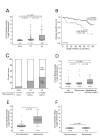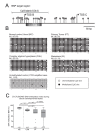Hypomethylation of the CTCFL/BORIS promoter and aberrant expression during endometrial cancer progression suggests a role as an Epi-driver gene
- PMID: 24658009
- PMCID: PMC4011582
- DOI: 10.18632/oncotarget.1697
Hypomethylation of the CTCFL/BORIS promoter and aberrant expression during endometrial cancer progression suggests a role as an Epi-driver gene
Abstract
Cancers arise through accumulating genetic and epigenetic alterations, considered relevant for phenotype and approaches to targeting new therapies. We investigated a unique collection of endometrial cancer precursor samples and clinically annotated primary and metastatic lesions for two evolutionary and functionally related transcription factors, CCCTC-binding factor (zinc finger protein) (CTCF) and its paralogue CTCF-like factor, also denoted Brother of the Regulator of Imprinted Sites (CTCFL/BORIS). CTCF, a chromatin modeling- and transcription factor, is normally expressed in a ubiquitous fashion, while CTCFL/BORIS is restricted to the testis. In cancer, CTCF is thought to be a tumor suppressor, while CTCFL/BORIS has been suggested as an oncogene. CTCF mutations were identified in 13%, with CTCF hotspot frameshift mutations at p.T204, all observed solely in the endometrioid subtype, but with no association with outcome. Interestingly, CTCFL/BORIS was amongst the top ranked genes differentially expressed between endometrioid and non-endometrioid tumors, and increasing mRNA level of CTCFL/BORIS was highly significantly associated with poor survival. As aberrant CTCFL/BORIS expression might relate to loss of methylation, we explored methylation status in clinical samples from complex atypical hyperplasia, through primary tumors to metastatic lesions, demonstrating a pattern of DNA methylation loss during disease development and progression in line with the increase in CTCFL/BORIS mRNA expression observed. Thus, CTCF and CTCFL/BORIS are found to diverge in the different subtypes of endometrial cancer, with CTCFL/BORIS activation through demethylation from precursors to metastatic lesions. We thus propose, CTCFL/BORIS as an Epi-driver gene in endometrial cancer, suggesting a potential for future vaccine development.
Figures



Similar articles
-
BORIS/CTCFL mRNA isoform expression and epigenetic regulation in epithelial ovarian cancer.Cancer Immun. 2013;13:6. Epub 2013 Jan 22. Cancer Immun. 2013. PMID: 23390377 Free PMC article.
-
DNA methylation-dependent regulation of BORIS/CTCFL expression in ovarian cancer.Cancer Immun. 2007 Dec 21;7:21. Cancer Immun. 2007. PMID: 18095639 Free PMC article.
-
Expression of the CTCF-paralogous cancer-testis gene, brother of the regulator of imprinted sites (BORIS), is regulated by three alternative promoters modulated by CpG methylation and by CTCF and p53 transcription factors.Nucleic Acids Res. 2007;35(21):7372-88. doi: 10.1093/nar/gkm896. Epub 2007 Oct 25. Nucleic Acids Res. 2007. PMID: 17962299 Free PMC article.
-
BORIS in human cancers -- a review.Eur J Cancer. 2012 Apr;48(6):929-35. doi: 10.1016/j.ejca.2011.09.009. Epub 2011 Oct 21. Eur J Cancer. 2012. PMID: 22019212 Review.
-
The novel BORIS + CTCF gene family is uniquely involved in the epigenetics of normal biology and cancer.Semin Cancer Biol. 2002 Oct;12(5):399-414. doi: 10.1016/s1044-579x(02)00060-3. Semin Cancer Biol. 2002. PMID: 12191639 Review.
Cited by
-
Review: Precision medicine and driver mutations: Computational methods, functional assays and conformational principles for interpreting cancer drivers.PLoS Comput Biol. 2019 Mar 28;15(3):e1006658. doi: 10.1371/journal.pcbi.1006658. eCollection 2019 Mar. PLoS Comput Biol. 2019. PMID: 30921324 Free PMC article. Review.
-
Candidate locus analysis of the TERT-CLPTM1L cancer risk region on chromosome 5p15 identifies multiple independent variants associated with endometrial cancer risk.Hum Genet. 2015 Feb;134(2):231-45. doi: 10.1007/s00439-014-1515-4. Epub 2014 Dec 9. Hum Genet. 2015. PMID: 25487306 Free PMC article. Clinical Trial.
-
Brother of the regulator of the imprinted site (BORIS) variant subfamily 6 is involved in cervical cancer stemness and can be a target of immunotherapy.Oncotarget. 2016 Mar 8;7(10):11223-37. doi: 10.18632/oncotarget.7165. Oncotarget. 2016. PMID: 26849232 Free PMC article.
-
BORIS: a key regulator of cancer stemness.Cancer Cell Int. 2018 Oct 5;18:154. doi: 10.1186/s12935-018-0650-8. eCollection 2018. Cancer Cell Int. 2018. PMID: 30323717 Free PMC article. Review.
-
CTCF and CTCFL in cancer.Curr Opin Genet Dev. 2020 Apr;61:44-52. doi: 10.1016/j.gde.2020.02.021. Epub 2020 Apr 22. Curr Opin Genet Dev. 2020. PMID: 32334335 Free PMC article. Review.
References
-
- Di Cristofano A, Ellenson LH. Endometrial carcinoma. Annual review of pathology. 2007;2:57–85. - PubMed
-
- Jones A, Teschendorff AE, Li Q, Hayward JD, Kannan A, Mould T, West J, Zikan M, Cibula D, Fiegl H, Lee SH, Wik E, Hadwin R, Arora R, Lemech C, Turunen H, et al. Role of DNA Methylation and Epigenetic Silencing of HAND2 in Endometrial Cancer Development. PLoS medicine. 2013;10(11):e1001551. - PMC - PubMed
-
- Salvesen HB, Haldorsen IS, Trovik J. Markers for individualised therapy in endometrial carcinoma. The lancet oncology. 2012;13(8):e353–361. - PubMed
-
- Fiorentino FP, Giordano A. The tumor suppressor role of CTCF. Journal of cellular physiology. 2012;227(2):479–492. - PubMed
MeSH terms
Substances
LinkOut - more resources
Full Text Sources
Other Literature Sources
Research Materials

